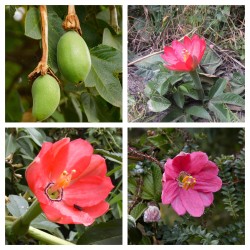Menu
-
MenuVissza
- Home
-
Kategóriák
-
-
Kategóriák
-
Zöldségmagok
-
Fajták országonként
- Fajták Örményország
- Fajták BiH
- Fajták Horvátországból
- Fajták Franciaországból
- Varieties from Germany
- Varieties from Greece
- Varieties from Hungary
- Fajták India
- Varieties from Italy
- Fajták Japánból
- Fajták Észak-Macedónia
- Varieties from Peru
- Varieties from Russia
- Varieties from Serbia
- Szlovéniából származó fajták
- Varieties from Spain
- Varieties from Thailand
- Fajták Törökország
- Varieties from USA
- Paradicsommag
- Kukoricamag
- Tök család magjai
- Babcsalád
- Uborka mag
- Paprikamag
- Sárgarépa család
- Hagyma család
- Saláta magok
- Burgonya család
- Káposzta család
- Retekmag
- Cékla család
- Görögdinnye magok
- Dinnye magok
- Karfiolmag
- Napraforgó család
-
Fajták országonként
- Gyümölcsmag
- Chili paprika magok
- Gyógynövénymagok
- Hegymászó növények magjai
- Fák - cserje - magok
- Pálma mag
- Díszes fűmagok
- Dohánymagok
-
Zöldségmagok
-
-
-
-
- ÚJ TERMÉKEK
- Fiók létrehozása
- Szállítás - fizetés
- FAQ
Last Product Reviews
Out of the two seeds, one germinated and the other one was dead and floatin...
By
 Riikka H on 07/03/2024
Riikka H on 07/03/2024
Verified Purchase
384 termék található.
346-360 / 384 elem mutatása
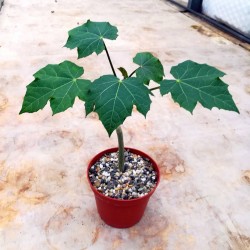
Fizikai dió - magvak...
Ár
3,75 €
(SKU: T 92)
Seeds Gallery EU,
5/
5
<h2><strong>Fizikai dió - magvak (Jatropha curcas)</strong></h2>
<h2><span style="color: #ff0a0a;"><strong>Ár egy csomag 3 magot.</strong></span></h2>
<p style="color: #202122; font-size: 14px;"><i><b>Jatropha curcas</b></i><span> </span>is a species of<span> </span>flowering plant<span> </span>in the<span> </span>spurge<span> </span>family,<span> </span>Euphorbiaceae, that is native to the<span> </span>American tropics, most likely<span> </span>Mexico<span> </span>and<span> </span>Central America.<sup id="cite_ref-Janick_2-0" class="reference" style="font-size: 11.2px;">[2]</sup><span> </span>It is originally native to the tropical areas of the Americas from Mexico to Argentina, and has been spread throughout the world in tropical and<span> </span>subtropical<span> </span>regions<span> </span>around the world, becoming<span> </span>naturalized or invasive<span> </span>in many areas.<sup id="cite_ref-cabi_3-0" class="reference" style="font-size: 11.2px;">[3]</sup><span> </span>The<span> </span>specific epithet,<span> </span><i>"curcas"</i>, was first used by<span> </span>Portuguese<span> </span>doctor<span> </span>Garcia de Orta<span> </span>more than 400 years ago.<sup id="cite_ref-Agroforest_4-0" class="reference" style="font-size: 11.2px;">[4]</sup><span> </span>Common names in English include<span> </span><b>physic nut</b>,<span> </span><b>Barbados nut</b>,<span> </span><b>poison nut</b>,<span> </span><b>bubble bush</b><span> </span>or<span> </span><b>purging nut</b>.<sup id="cite_ref-cabi_3-1" class="reference" style="font-size: 11.2px;">[3]</sup><span> </span>In parts of Africa and areas in Asia such as India it is often known as "castor oil plant" or "hedge castor oil plant",<sup id="cite_ref-cabi_3-2" class="reference" style="font-size: 11.2px;">[3]</sup><span> </span>but it is not the same as the usual<span> </span>castor oil plant,<span> </span><i>Ricinus communis</i><span> </span>(they are in the same family but different subfamilies).</p>
<p style="color: #202122; font-size: 14px;"><i>J. curcas</i><span> </span>is a semi-evergreen<span> </span>shrub<span> </span>or small<span> </span>tree, reaching a height of 6 m (20 ft) or more.<sup id="cite_ref-Janick_2-1" class="reference" style="font-size: 11.2px;">[2]</sup><span> </span>It is resistant to a high degree of<span> </span>aridity, allowing it to grow in<span> </span>deserts.<sup id="cite_ref-5" class="reference" style="font-size: 11.2px;">[5]</sup><sup id="cite_ref-6" class="reference" style="font-size: 11.2px;">[6]</sup><span> </span>It contains<span> </span>phorbol esters, which are considered toxic.<sup id="cite_ref-7" class="reference" style="font-size: 11.2px;">[7]</sup><span> </span>However, edible (non-toxic) provenances native to Mexico also exist, known by the local population as piñón manso, xuta, chuta, aishte, among others.<sup id="cite_ref-Martínez-Herrera,_J._2010_8-0" class="reference" style="font-size: 11.2px;">[8]</sup><sup id="cite_ref-valdez2013_9-0" class="reference" style="font-size: 11.2px;">[9]</sup><span> </span><i>J. curcas</i><span> </span>also contains compounds such as<span> </span>trypsin inhibitors,<span> </span>phytate,<span> </span>saponins<span> </span>and a type of<span> </span>lectin<sup id="cite_ref-10" class="reference" style="font-size: 11.2px;">[10]</sup><sup id="cite_ref-11" class="reference" style="font-size: 11.2px;">[11]</sup><span> </span>known as curcin.<sup id="cite_ref-12" class="reference" style="font-size: 11.2px;">[12]</sup></p>
<p style="color: #202122; font-size: 14px;">The<span> </span>seeds<span> </span>contain 27–40%<span> </span>oil<sup id="cite_ref-13" class="reference" style="font-size: 11.2px;">[13]</sup><span> </span>(average: 34.4%<sup id="cite_ref-14" class="reference" style="font-size: 11.2px;">[14]</sup>) that can be processed to produce a high-quality<span> </span>biodiesel<span> </span>fuel, usable in a standard<span> </span>diesel engine. Edible (non-toxic) varieties can be used for<span> </span>animal feed<span> </span>and food.</p>
<h2 style="color: #000000; font-size: 1.5em;"><span class="mw-headline" id="Botanical_features">Botanical features</span></h2>
<ul>
<li>Leaves: The leaves have significant variability in their morphology. In general, the leaves are green to pale green, alternate to subopposite, and three- to five-lobed with a<span> </span>spiral phyllotaxis.<sup id="cite_ref-Nahar_16-0" class="reference" style="font-size: 11.2px;">[16]</sup></li>
<li>Flowers: male and female flowers are produced on the same<span> </span>inflorescence, averaging 20 male flowers to each female flower,<sup id="cite_ref-Pesquisa_17-0" class="reference" style="font-size: 11.2px;">[17]</sup><span> </span>or 10 male flowers to each female flower.<sup id="cite_ref-Jatropha_journal_18-0" class="reference" style="font-size: 11.2px;">[18]</sup><span> </span>The inflorescence can be formed in the<span> </span>leaf axil. Plants occasionally present hermaphroditic flowers.<sup id="cite_ref-Nahar_16-1" class="reference" style="font-size: 11.2px;">[16]</sup></li>
<li>Fruits : fruits are produced in winter, or there may be several crops during the year if soil moisture is good and temperatures are sufficiently high. Most fruit production is concentrated from midsummer to late fall with variations in production peaks where some plants have two or three harvests and some produce continuously through the season.<sup id="cite_ref-Nahar_16-2" class="reference" style="font-size: 11.2px;">[16]</sup></li>
<li>Seeds: the seeds are mature when the capsule changes from green to yellow. The seeds contain around 20% saturated fatty acids and 80% unsaturated fatty acids, and they yield 25–40% oil by weight. In addition, the seeds contain other chemical compounds, such as<span> </span>saccharose,<span> </span>raffinose,<span> </span>stachyose,<span> </span>glucose,<span> </span>fructose,<span> </span>galactose, and<span> </span>protein. The oil is largely made up of oleic and<span> </span>linoleic<span> </span>acids. Furthermore, the plant also contains curcasin, arachidic,<span> </span>myristic,<span> </span>palmitic, and<span> </span>stearic<span> </span>acids and<span> </span>curcin.<sup id="cite_ref-Nahar_16-3" class="reference" style="font-size: 11.2px;">[16]</sup></li>
<li>Genome: the whole genome was sequenced by<span> </span><i>Kazusa DNA Research Institute</i>, Chiba Japan in October 2010.</li>
</ul>
<h2 style="color: #000000; font-size: 1.5em;"><span class="mw-headline" id="Cultivation">Cultivation</span></h2>
<p style="color: #202122; font-size: 14px;">Cultivation is uncomplicated.<span> </span><i>Jatropha curcas</i><span> </span>grows in<span> </span>tropical<span> </span>and<span> </span>subtropical<span> </span>regions.<sup id="cite_ref-20" class="reference" style="font-size: 11.2px;">[20]</sup><span> </span>The plant can grow in<span> </span>wastelands<span> </span>and grows on almost any terrain, even on<span> </span>gravelly,<span> </span>sandy<span> </span>and<span> </span>saline<span> </span>soils. It can thrive in poor and stony soils, although new research suggests that the plant's ability to adapt to these poor soils is not as extensive as had been previously stated. Complete<span> </span>germination<span> </span>is achieved within 9 days. Adding<span> </span>manure<span> </span>during the germination has negative effects during that phase, but is favorable if applied after germination is achieved. It can be propagated by cuttings, which yields faster results than multiplication by seeds.</p>
<p style="color: #202122; font-size: 14px;">The flowers only develop terminally (at the end of a stem), so a good ramification (plants presenting many branches) produces the greatest amount of fruits. The plants are<span> </span>self-compatible.<sup id="cite_ref-Pesquisa_17-1" class="reference" style="font-size: 11.2px;">[17]</sup><span> </span>Another productivity factor is the ratio between female and male flowers within an inflorescence, more female flowers mean more fruits.<sup id="cite_ref-Jatropha_journal_18-1" class="reference" style="font-size: 11.2px;">[18]</sup><span> </span><i>Jatropha curcas</i><span> </span>thrives on a mere 250 mm (10 in) of rain a year, and only during its first two years does it need to be watered in the closing days of the dry season.<span> </span>Ploughing<span> </span>and planting are not needed regularly, as this shrub has a life expectancy of approximately forty years. The use of<span> </span>pesticides<span> </span>is not necessary, due to the pesticidal and<span> </span>fungicidal<span> </span>properties of the plant. It is used in rural Bengal for<span> </span>dhobi itch<span> </span>(a common fungal infection of the skin).</p>
<p style="color: #202122; font-size: 14px;">While<span> </span><i>Jatropha curcas</i><span> </span>starts yielding from 9–12 months time, the best yields are obtained only after 2–3 years time. The seed production is around 3.5 tons per hectare (seed production ranges from about 0.4 t/ha in the first year to over 5 t/ha after 3 years). If planted in<span> </span>hedges, the reported productivity of<span> </span><i>Jatropha</i><span> </span>is from 0.8 to 1.0 kg of seed per meter of live fence.<sup class="noprint Inline-Template Template-Fact" style="font-size: 11.2px;">[<i><span title="This claim needs references to reliable sources. (April 2015)">citation needed</span></i>]</sup></p>
<h2 style="color: #000000; font-size: 1.5em;"><span class="mw-headline" id="Propagation">Propagation</span></h2>
<p style="color: #202122; font-size: 14px;"><i>Jatropha curcas</i><span> </span>can easily be propagated by both<span> </span>seed<span> </span>or cuttings.<sup id="cite_ref-Duke_21-0" class="reference" style="font-size: 11.2px;"></sup><span> </span>Some people recommend propagation by seed for establishment of long-lived plantations.<sup id="cite_ref-Duong_22-0" class="reference" style="font-size: 11.2px;">[22]</sup><span> </span>When jatropha plants develop from cuttings, they produce many branches but yield fewer seeds and do not have enough time to develop their taproot, which makes them sensitive to wind erosion.<sup id="cite_ref-feed_23-0" class="reference" style="font-size: 11.2px;">[23]</sup><span> </span>The seeds exhibit orthodox storage behaviour and under normal treatment and storage will maintain viability at high percentages for eight months to a year.<sup id="cite_ref-24" class="reference" style="font-size: 11.2px;">[24]</sup><sup id="cite_ref-25" class="reference" style="font-size: 11.2px;">[25]</sup><sup id="cite_ref-26" class="reference" style="font-size: 11.2px;">[26]</sup><sup id="cite_ref-Duong_22-1" class="reference" style="font-size: 11.2px;">[22]</sup><sup id="cite_ref-27" class="reference" style="font-size: 11.2px;">[27]</sup><span> </span>Propagation through seed (sexual propagation) leads to a lot of genetic variability in terms of growth, biomass, seed yield and oil content. Clonal techniques can help in overcoming these problems. Vegetative propagation has been achieved by<span> </span>stem cuttings,<span> </span>grafting,<span> </span>budding<span> </span>as well as by<span> </span>air layering<span> </span>techniques. Cuttings should be taken preferably from juvenile plants and treated with 200 micro gram per litre of<span> </span>IBA<span> </span>(rooting hormone) to ensure the highest level of rooting in stem cuttings.<sup id="cite_ref-28" class="reference" style="font-size: 11.2px;">[28]</sup><span> </span>Cuttings strike root easily stuck in the ground without use of hormones.</p>
<h2 style="color: #000000; font-size: 1.5em;"><span class="mw-headline" id="Processing">Processing</span></h2>
<p style="color: #202122; font-size: 14px;">Seed extraction and processing generally needs specialized facilities.</p>
<p style="color: #202122; font-size: 14px;">Oil content varies from 28% to 30% and 80% extraction, one<span> </span>hectare<span> </span>of plantation will give 400 to 600 litres of oil if the soil is average.<sup id="cite_ref-29" class="reference" style="font-size: 11.2px;">[29]</sup></p>
<p style="color: #202122; font-size: 14px;">The oily seeds are processed into<span> </span>oil, which may be used directly ("Straight Vegetable Oil") to fuel combustion engines or may be subjected to<span> </span>transesterification<span> </span>to produce<span> </span>biodiesel.<sup class="noprint Inline-Template Template-Fact" style="font-size: 11.2px;">[<i><span title="This claim needs references to reliable sources. (December 2016)">citation needed</span></i>]</sup><span> </span>Jatropha oil is not suitable for human consumption, as it induces strong<span> </span>vomiting<span> </span>and<span> </span>diarrhea.<sup class="noprint Inline-Template Template-Fact" style="font-size: 11.2px;">[<i><span title="This claim needs references to reliable sources. (December 2016)">citation needed</span></i>]</sup></p>
<h2 style="color: #000000; font-size: 1.5em;"><span class="mw-headline" id="Biofuel">Biofuel</span></h2>
<div class="thumb tright" style="color: #202122; font-size: 14px;">
<div class="thumbinner" style="font-size: 13.16px;"><img alt="" src="https://upload.wikimedia.org/wikipedia/commons/thumb/1/13/Jatropha_in_Paraguay_Chaco.jpg/220px-Jatropha_in_Paraguay_Chaco.jpg" decoding="async" width="220" height="322" class="thumbimage" srcset="//upload.wikimedia.org/wikipedia/commons/thumb/1/13/Jatropha_in_Paraguay_Chaco.jpg/330px-Jatropha_in_Paraguay_Chaco.jpg 1.5x, //upload.wikimedia.org/wikipedia/commons/thumb/1/13/Jatropha_in_Paraguay_Chaco.jpg/440px-Jatropha_in_Paraguay_Chaco.jpg 2x" data-file-width="684" data-file-height="1000">
<div class="thumbcaption" style="font-size: 12.3704px;">
<div class="magnify"></div>
Jatropha plantation in the dry center/west of the<span> </span>Paraguay<span> </span>Chaco</div>
</div>
</div>
<p style="color: #202122; font-size: 14px;">When jatropha seeds are crushed, the resulting jatropha oil can be processed to produce a high-quality<span> </span>biofuel<span> </span>or<span> </span>biodiesel<span> </span>that can be used in a standard diesel car or further processed into jet fuel, while the residue (press cake) can also be used as biomass feedstock to power electricity plants, used as fertilizer (it contains nitrogen, phosphorus and potassium). The cake can also be used as feed in<span> </span>digesters<span> </span>and gasifiers to produce biogas.<sup id="cite_ref-30" class="reference" style="font-size: 11.2px;">[30]</sup></p>
<div class="thumb tright" style="color: #202122; font-size: 14px;">
<div class="thumbinner" style="font-size: 13.16px;"><img alt="" src="https://upload.wikimedia.org/wikipedia/commons/thumb/7/73/Sedari_Menanam_Hingga_Memetik.jpg/220px-Sedari_Menanam_Hingga_Memetik.jpg" decoding="async" width="220" height="309" class="thumbimage" srcset="//upload.wikimedia.org/wikipedia/commons/thumb/7/73/Sedari_Menanam_Hingga_Memetik.jpg/330px-Sedari_Menanam_Hingga_Memetik.jpg 1.5x, //upload.wikimedia.org/wikipedia/commons/thumb/7/73/Sedari_Menanam_Hingga_Memetik.jpg/440px-Sedari_Menanam_Hingga_Memetik.jpg 2x" data-file-width="1200" data-file-height="1683">
<div class="thumbcaption" style="font-size: 12.3704px;">
<div class="magnify"></div>
<i>"From planting to picking. Treat your jatropha plant as well as possible to make the yield as large as possible!"</i><span> </span>(A reference to the compulsory planting of jatropha in Indonesia for the production of oil as machinery lubricant and fuel for the Japanese WWII war effort.)</div>
</div>
</div>
<p style="color: #202122; font-size: 14px;">There are several forms of biofuel, often manufactured using<span> </span>sedimentation,<span> </span>centrifugation, and<span> </span>filtration. The fats and oils are turned into esters while separating the<span> </span>glycerin. At the end of the process, the glycerin settles and the biofuel floats. The process through which the glycerin is separated from the biodiesel is known as<span> </span>transesterification. Glycerin is another by-product from Jatropha oil processing that can add value to the crop. Transesterification is a simple chemical reaction that neutralizes the free fatty acids present in any fatty substances in Jatropha. A chemical exchange takes place between the<span> </span>alkoxy<span> </span>groups of an ester compound by an alcohol. Usually,<span> </span>methanol<span> </span>and<span> </span>ethanol<span> </span>are used for the purpose. The reaction occurs by the presence of a<span> </span>catalyst, usually sodium hydroxide (NaOH) or caustic soda and potassium hydroxide (KOH), which forms fatty esters (e.g., methyl or ethyl esters), commonly known as<span> </span>biodiesel. It takes approximately 10% of methyl alcohol by weight of the fatty substance to start the transesterification process.<sup id="cite_ref-Nahar_16-4" class="reference" style="font-size: 11.2px;">[16]</sup></p>
<p style="color: #202122; font-size: 14px;">Estimates of<span> </span><i>Jatropha</i><span> </span>seed yield vary widely, due to a lack of research data, the<span> </span>genetic<span> </span>diversity of the crop, the range of<span> </span>environments<span> </span>in which it is grown, and<span> </span><i>Jatropha</i><span class="nowrap">'</span>s perennial life cycle. Seed yields under cultivation can range from 1,500 to 2,000 kilograms per<span> </span>hectare, corresponding to extractable oil yields of 540 to 680 litres per hectare (58 to 73 gallons per acre).<sup id="cite_ref-31" class="reference" style="font-size: 11.2px;">[31]</sup><span> </span>In 2009<span> </span><i>Time</i><span> </span>magazine cited the potential for as much as 1,600 gallons of diesel fuel per acre per year.<sup id="cite_ref-32" class="reference" style="font-size: 11.2px;">[32]</sup><span> </span>The plant may yield more than four times as much fuel per<span> </span>hectare<span> </span>as<span> </span>soybean, and more than ten times that of<span> </span>maize<span> </span>(corn), but at the same time it requires five times as much water per unit of energy produced as does corn (see below). A hectare of jatropha has been claimed to produce 1,892 litres of fuel.<sup id="cite_ref-33" class="reference" style="font-size: 11.2px;">[33]</sup><span> </span>However, as it has not yet been domesticated or improved by plant breeders, yields are variable.<sup id="cite_ref-Fairless_34-0" class="reference" style="font-size: 11.2px;">[34]</sup></p>
<p style="color: #202122; font-size: 14px;"><i>Jatropha</i><span> </span>can also be<span> </span>intercropped<span> </span>with other cash crops such as coffee, sugar, fruits and vegetables.<sup id="cite_ref-reuk_35-0" class="reference" style="font-size: 11.2px;">[35]</sup></p>
<p style="color: #202122; font-size: 14px;">In 2007<span> </span>Goldman Sachs<span> </span>cited<span> </span><i>Jatropha curcas</i><span> </span>as one of the best candidates for future biodiesel production.<sup id="cite_ref-online.wsj.com_36-0" class="reference" style="font-size: 11.2px;">[36]</sup><span> </span>However, despite its abundance and use as an oil and<span> </span>reclamation<span> </span>plant, none of the<span> </span><i>Jatropha</i><span> </span>species has been properly<span> </span>domesticated<span> </span>and, as a result, its productivity is variable, and the long-term impact of its large-scale use on soil quality and the environment is unknown.<sup id="cite_ref-Fairless2_37-0" class="reference" style="font-size: 11.2px;">[37]</sup></p>
<p style="color: #202122; font-size: 14px;">In 2008 researchers at Daimler Chrysler Research explored the use of jatropha oil for automotive use, concluding that although jatropha oil as fuel "has not yet reached optimal quality, ... it already fulfills the EU norm for biodiesel quality".<span> </span>Archer Daniels Midland Company,<span> </span>Bayer CropScience<span> </span>and<span> </span>Daimler AG<span> </span>have a joint project to develop jatropha as a biofuel.<sup id="cite_ref-38" class="reference" style="font-size: 11.2px;">[38]</sup><span> </span>Three Mercedes cars powered by Jatropha diesel have already put some 30,000 kilometres behind them. The project is supported by<span> </span>DaimlerChrysler<span> </span>and by the German Association for Investment and Development (Deutschen Investitions- und Entwicklungsgesellschaft, DEG).</p>
<h3 style="color: #000000; font-size: 1.2em;"><span class="mw-headline" id="Jet_fuel">Jet fuel</span></h3>
<p style="color: #202122; font-size: 14px;">Aviation fuels may be more widely replaced by biofuels such as jatropha oil than fuels for other forms of transportation. There are fewer planes than cars or trucks and far fewer jet fueling stations to convert than gas stations.<sup id="cite_ref-nytimes12-30_39-0" class="reference" style="font-size: 11.2px;">[39]</sup><span> </span>To fulfil the yearly demand for aviation fuel, based on demand in 2008 (fuel use has since grown), an area of farmland twice the size of France would need to be planted with jatropha, based on average yields of mature plantations on reasonably good, irrigated land.<sup id="cite_ref-40" class="reference" style="font-size: 11.2px;">[40]</sup></p>
<p style="color: #202122; font-size: 14px;">On December 30, 2008,<span> </span>Air New Zealand<span> </span>flew the first successful test flight from<span> </span>Auckland<span> </span>with a<span> </span>Boeing 747<span> </span>running one of its four<span> </span>Rolls-Royce<span> </span>engines on a 50:50 blend of jatropha oil and<span> </span>jet A-1 fuel.<sup id="cite_ref-nytimes12-30_39-1" class="reference" style="font-size: 11.2px;">[39]</sup><sup id="cite_ref-41" class="reference" style="font-size: 11.2px;">[41]</sup><span> </span>In the same press release, Air New Zealand announced plans to use the new fuel for 10% of its needs by 2013. At the time of this test, jatropha oil was much cheaper than crude oil, costing an estimated $43 a barrel or about one-third of the June 4, 2008 closing price of $122.30 for a<span> </span>barrel<span> </span>of<span> </span>crude oil.<sup id="cite_ref-42" class="reference" style="font-size: 11.2px;">[42]</sup></p>
<p style="color: #202122; font-size: 14px;">On January 7, 2009 Continental Airlines successfully completed a test flight from Houston, Texas using a 50/50 mixture of algae/jatropha-oil-derived biofuel and Jet A in one of the two CFM56 engines of a Boeing 737-800 Next Generation jet. The two-hour test flight could mark another promising step for the airline industry to find cheaper and more<span> </span>environmentally friendly<span> </span>alternatives to<span> </span>fossil fuel.</p>
<p style="color: #202122; font-size: 14px;">On April 1, 2011<span> </span>Interjet<span> </span>completed the first Mexican aviation biofuels test flight on an<span> </span>Airbus A320. The fuel was a 70:30 traditional jet fuel biojet blend produced from Jatropha oil provided by three Mexican producers, Global Energías Renovables (a wholly owned subsidiary of U.S.-based<span> </span>Global Clean Energy Holdings), Bencafser S.A. and Energy JH S.A. Honeywell's UOP processed the oil into Bio-SPK (Synthetic Paraffinic Kerosene).<sup id="cite_ref-BiodeiselsMexico_43-0" class="reference" style="font-size: 11.2px;">[43]</sup><span> </span>Global Energías Renovables operates the largest Jatropha farm in the Americas.<sup id="cite_ref-BiodeiselsMexico_43-1" class="reference" style="font-size: 11.2px;">[43]</sup></p>
<p style="color: #202122; font-size: 14px;">On October 28, 2011<span> </span>Air China<span> </span>completed the first successful demonstration flight by a Chinese airline that used jatropha-based biofuel. The mixture was a 50:50 mix of conventional jet fuel blended with jatropha oil from China National Petroleum Corp. The 747-400 powered one of its four engines on the fuel mixture during the 1-hour flight around Beijing airport.<sup id="cite_ref-44" class="reference" style="font-size: 11.2px;">[44]</sup></p>
<p style="color: #202122; font-size: 14px;">On August 27, 2018<span> </span>SpiceJet<span> </span>completed the first successful test flight by an Indian airline which used jatropha based biofuel. The ratio of conventional jet fuel to jatropha oil was 25:75.<sup id="cite_ref-45" class="reference" style="font-size: 11.2px;">[45]</sup></p>
<h3 style="color: #000000; font-size: 1.2em;"><span class="mw-headline" id="Carbon_dioxide_sequestration">Carbon dioxide sequestration</span></h3>
<p style="color: #202122; font-size: 14px;">According to a 2013 study published by the<span> </span>European Geosciences Union,<sup id="cite_ref-46" class="reference" style="font-size: 11.2px;">[46]</sup><span> </span>the jatropha tree may have applications in the absorption of carbon dioxide, whose sequestration is important in<span> </span>combating climate change.<sup id="cite_ref-47" class="reference" style="font-size: 11.2px;">[47]</sup><span> </span>This small tree is very resistant to aridity so it can be planted in hot and dry land in soil unsuitable for food production. The plant does need water to grow though, so coastal areas where desalinated seawater can be made available are ideal.</p>
<h3 style="color: #000000; font-size: 1.2em;"><span class="mw-headline" id="Use_in_developing_world">Use in developing world</span></h3>
<p style="color: #202122; font-size: 14px;">Currently the oil from<span> </span><i>Jatropha curcas</i><span> </span>seeds<span> </span>is used for making<span> </span>biodiesel<span> </span>fuel in<span> </span>Philippines,<span> </span>Pakistan<span> </span>and in<span> </span>Brazil, where it grows naturally and in plantations in the southeast, north, and northeast of Brazil. In the<span> </span>Gran Chaco<span> </span>of<span> </span>Paraguay, where a native variety (<i>Jatropha matacensis</i>) also grows, studies have shown the suitability of Jatropha cultivation<sup id="cite_ref-48" class="reference" style="font-size: 11.2px;">[48]</sup><sup id="cite_ref-49" class="reference" style="font-size: 11.2px;">[49]</sup><span> </span>and agro producers are starting to consider planting in the region.<sup id="cite_ref-50" class="reference" style="font-size: 11.2px;">[50]</sup><span> </span>In Africa, cultivation of<span> </span><i>jatropha</i><span> </span>is being promoted and it is grown successfully in countries such as<span> </span>Mali.<sup id="cite_ref-51" class="reference" style="font-size: 11.2px;">[51]</sup></p>
<h4 style="color: #000000; font-size: 14px;"><span class="mw-headline" id="India">India</span></h4>
<div role="note" class="hatnote navigation-not-searchable" style="color: #202122; font-size: 14px;">Further information:<span> </span>Jatropha biodiesel in India</div>
<p style="color: #202122; font-size: 14px;">Jatropha oil is being promoted as an easily grown biofuel crop in hundreds of projects throughout India.<sup id="cite_ref-WAC_52-0" class="reference" style="font-size: 11.2px;">[52]</sup><span> </span>Large plantings and nurseries have been undertaken in India by many research institutions, and by women's<span> </span>self-help<span> </span>groups who use a system of<span> </span>microcredit<span> </span>to ease poverty among semiliterate Indian women. The<span> </span>railway line<span> </span>between<span> </span>Mumbai<span> </span>and<span> </span>Delhi<span> </span>is planted with<span> </span><i>jatropha</i><span> </span>and the train itself runs on 15–20%<span> </span>biodiesel.<sup id="cite_ref-Fairless_34-1" class="reference" style="font-size: 11.2px;">[34]</sup></p>
<h4 style="color: #000000; font-size: 14px;"><span class="mw-headline" id="Myanmar">Myanmar</span><span class="mw-editsection" style="font-size: small;"><span class="mw-editsection-bracket" style="color: #54595d;">[</span>edit<span class="mw-editsection-bracket" style="color: #54595d;">]</span></span></h4>
<table class="box-Unreferenced_section plainlinks metadata ambox ambox-content ambox-Unreferenced" role="presentation" style="color: #202122; font-size: 14px;">
<tbody>
<tr>
<td class="mbox-image">
<div><img alt="" src="https://upload.wikimedia.org/wikipedia/en/thumb/9/99/Question_book-new.svg/50px-Question_book-new.svg.png" decoding="async" width="50" height="39" srcset="//upload.wikimedia.org/wikipedia/en/thumb/9/99/Question_book-new.svg/75px-Question_book-new.svg.png 1.5x, //upload.wikimedia.org/wikipedia/en/thumb/9/99/Question_book-new.svg/100px-Question_book-new.svg.png 2x" data-file-width="512" data-file-height="399"></div>
</td>
<td class="mbox-text">
<div class="mbox-text-span">This section<span> </span><b>does not<span> </span>cite<span> </span>any<span> </span>sources</b>.<span class="hide-when-compact"><span> </span>Please help<span> </span>improve this section<span> </span>by<span> </span>adding citations to reliable sources. Unsourced material may be challenged and<span> </span>removed.</span><span> </span><span class="date-container"><i>(<span class="date">December 2016</span>)</i></span><span class="hide-when-compact"><i><span> </span>(Learn how and when to remove this template message)</i></span></div>
</td>
</tr>
</tbody>
</table>
<p style="color: #202122; font-size: 14px;">Myanmar<span> </span>is also actively pursuing the use of jatropha oil. On 15 December 2005, then-head of state, Senior General<span> </span>Than Shwe, said “the States and Divisions concerned are to put 50,000 acres (200 km²) under the physic nut plants [Jatropha] each within three years totalling 700,000 acres (2,800 km²) during the period”. On the occasion of Burma’s Peasant Day 2006, Than Shwe described in his a message that “For energy sector which is an essential role in transforming industrial agriculture system, the Government is encouraging for cultivation of physic nut plants nationwide and the technical know how that can refine physic nuts to biodiesel has also identified.” He would like to urge peasants to cultivate physic nut plants on a commercial scale with major aims for emergence of industrial agriculture system, for fulfilling rural electricity supply and energy needs, for supporting rural areas development and import substitute economy. (2005 from MRTV)</p>
<p style="color: #202122; font-size: 14px;">In 2006, the chief research officer at state-run<span> </span>Myanma Oil and Gas Enterprise<span> </span>said Burma hoped to completely replace the country's oil imports of 40,000 barrels a day with home-brewed, jatropha-derived biofuel. Other government officials declared Burma would soon start exporting jatropha oil. Despite the military's efforts, the jatropha campaign apparently has largely flopped in its goal of making Burma self-sufficient in fuel. (2006 from MyawaddyTV)</p>
<p style="color: #202122; font-size: 14px;">Z.G.S. Bioenergy has started Jatropha Plantation Projects in Northern<span> </span>Shan State, the company has begun planting Jatropha plants during late June 2007 and will start producing seeds by 2010. (20 July 2007 from New Light of Myanmar)</p>
<h3 style="color: #000000; font-size: 1.2em;"><span class="mw-headline" id="Controversies">Controversies</span></h3>
<p style="color: #202122; font-size: 14px;">As of 2011 scepticism about the "miracle" properties of<span> </span><i>Jatropha</i><span> </span>has been voiced. For example: "The idea that jatropha can be grown on marginal land is a<span> </span>red herring", according to Harry Stourton, former business development director of UK-based Sun Biofuels, which attempted to cultivate<span> </span><i>Jatropha</i><span> </span>in Mozambique and Tanzania. "It does grow on marginal land, but if you use marginal land you'll get marginal yields," he said.<sup id="cite_ref-53" class="reference" style="font-size: 11.2px;">[53]</sup><sup id="cite_ref-54" class="reference" style="font-size: 11.2px;">[54]</sup><span> </span>Sun Biofuels, after failing to adequately compensate local farmers for the land acquired for their plantation in Tanzania, pay workers severance, or deliver promised supplies to local villagers, went bankrupt later in 2011, the villager farmland being sold to an offshore investment fund.<sup id="cite_ref-55" class="reference" style="font-size: 11.2px;">[55]</sup></p>
<p style="color: #202122; font-size: 14px;">An August 2010 article warned about the actual utility and potential dangers of reliance on<span> </span><i>Jatropha</i><span> </span>in Kenya. Major concerns included its invasiveness, which could disrupt local biodiversity, as well as damage to water catchment areas.<sup id="cite_ref-56" class="reference" style="font-size: 11.2px;">[56]</sup></p>
<p style="color: #202122; font-size: 14px;"><i>Jatropha curcas</i><span> </span>is lauded as being sustainable, and that its production would not compete with food production, but the jatropha plant needs water like every other crop to grow. This could create competition for water between the jatropha and other edible food crops. In fact, jatropha requires five times more water per unit of energy than sugarcane and corn.<sup id="cite_ref-57" class="reference" style="font-size: 11.2px;">[57]</sup><sup id="cite_ref-58" class="reference" style="font-size: 11.2px;">[58]</sup></p>
<h2 style="color: #000000; font-size: 1.5em;"><span class="mw-headline" id="Food_for_human_consumption">Food for human consumption</span></h2>
<p style="color: #202122; font-size: 14px;"><i>Xuta</i>,<span> </span><i>chuta</i>,<span> </span><i>aishte</i><span> </span>or<span> </span><i>piñón manso</i><span> </span>(among others) are some of the names given in<span> </span>Mexico<span> </span>to edible non-toxic<span> </span><i>Jatropha curcas</i>.<sup id="cite_ref-Universidad_59-0" class="reference" style="font-size: 11.2px;">[59]</sup><sup id="cite_ref-valdez2013_9-1" class="reference" style="font-size: 11.2px;">[9]</sup><span> </span>It is grown in house gardens or other small areas.<sup id="cite_ref-Universidad_59-1" class="reference" style="font-size: 11.2px;">[59]</sup><span> </span>Although it is known as a toxic plant due to the presence of diterpenes named phorbol esters,<sup id="cite_ref-60" class="reference" style="font-size: 11.2px;">[60]</sup><span> </span>the existence of edible non-toxic<span> </span><i>J. curcas</i><span> </span>without phorbol esters content has been demonstrated.<sup id="cite_ref-valdez2013_9-2" class="reference" style="font-size: 11.2px;">[9]</sup><sup id="cite_ref-Osuna_61-0" class="reference" style="font-size: 11.2px;">[61]</sup><span> </span>It is also similarly reported that<span> </span><i>Jatropha</i><span> </span>seeds are edible once the embryo has been removed.<sup id="cite_ref-62" class="reference" style="font-size: 11.2px;">[62]</sup><span> </span>The process for analysis of phorbol ester contents in<span> </span><i>J. curcas</i><span> </span>is done through<span> </span>high-performance liquid chromatography<span> </span>(HPLC).<sup id="cite_ref-Makkar_63-0" class="reference" style="font-size: 11.2px;">[63]</sup></p>
<p style="color: #202122; font-size: 14px;">Xuta is traditionally prepared for local celebrations or popular parties. The kernels are roasted and eaten as a snack or roasted and ground to prepare different dishes, such as<span> </span>tamales, soups and sauces like “pipian”.<sup id="cite_ref-valdez2013_9-3" class="reference" style="font-size: 11.2px;">[9]</sup><sup id="cite_ref-Osuna_61-1" class="reference" style="font-size: 11.2px;">[61]</sup><span> </span>The seeds in the zone around Misantla, Veracruz are very appreciated by the population as food once they have been boiled and roasted.</p>
<p style="color: #202122; font-size: 14px;">Root ashes are used as a salt substitute.<span> </span>HCN<span> </span>and<span> </span>rotenone<span> </span>are present.<sup id="cite_ref-64" class="reference" style="font-size: 11.2px;">[64]</sup></p>
<h2 style="color: #000000; font-size: 1.5em;"><span class="mw-headline" id="Other_uses">Other uses</span></h2>
<ul style="color: #202122; font-size: 14px;">
<li><b>Flowers</b></li>
</ul>
<dl style="color: #202122; font-size: 14px;">
<dd>The species is listed as a<span> </span>honey<span> </span>plant.<span> </span>Hydrogen cyanide is present.<sup id="cite_ref-65" class="reference" style="font-size: 11.2px;">[65]</sup></dd>
</dl>
<ul style="color: #202122; font-size: 14px;">
<li><b>Nuts</b></li>
</ul>
<dl style="color: #202122; font-size: 14px;">
<dd>Can be construed for home cooking fuel in briquette form replacing charcoalized timber as in Haiti.<sup id="cite_ref-Glenn_Brooks_Jachob_e3_66-0" class="reference" style="font-size: 11.2px;">[66]</sup></dd>
<dd>They can be burned like<span> </span>candlenuts<span> </span>when strung on grass.<sup class="noprint Inline-Template Template-Fact" style="font-size: 11.2px;">[<i><span title="This claim needs references to reliable sources. (October 2014)">citation needed</span></i>]</sup><span> </span>HCN<span> </span>is present.<sup id="cite_ref-67" class="reference" style="font-size: 11.2px;"></sup></dd>
<dd>Used as a<span> </span>contraceptive<span> </span>in South Sudan.<sup id="cite_ref-autogenerated1_68-0" class="reference" style="font-size: 11.2px;">[68]</sup></dd>
</dl>
<ul style="color: #202122; font-size: 14px;">
<li><b>Seeds</b></li>
</ul>
<dl style="color: #202122; font-size: 14px;">
<dd>Interest exists in producing animal feed<sup class="noprint Inline-Template Template-Fact" style="font-size: 11.2px;">[<i><span title="This claim needs references to reliable sources. (October 2014)">citation needed</span></i>]</sup><span> </span>from the bio-waste once the oil is expressed, as in the case with Haiti, where Jatropha curcas grows prolifically and animal feed is in very short supply.<sup id="cite_ref-Glenn_Brooks_Jachob_e3_66-1" class="reference" style="font-size: 11.2px;">[66]</sup></dd>
<dd>Similarly, Metsiyen in the Haitian culture dates back as a medicinal crop—thus the name "metsiyen"/"medsiyen". Some suggest it "calms the stomach".<sup id="cite_ref-Glenn_Brooks_Jachob_e3_66-2" class="reference" style="font-size: 11.2px;">[66]</sup></dd>
<dd>Also used as a contraceptive in South Sudan.<sup id="cite_ref-autogenerated1_68-1" class="reference" style="font-size: 11.2px;">[68]</sup></dd>
<dd>The oil has been used for illumination,<span> </span>soap,<span> </span>candles, the<span> </span>adulteration<span> </span>of<span> </span>olive oil, and making<span> </span>Turkey red oil.<span> </span>Turkey red oil, also called sulphonated (or sulfated) castor oil, is the only oil that completely disperses in water. It is made by adding<span> </span>sulfuric acid<span> </span>to pure<span> </span><i>Jatropha</i><span> </span>oil.<sup id="cite_ref-69" class="reference" style="font-size: 11.2px;">[69]</sup><span> </span>It was the first synthetic<span> </span>detergent<span> </span>after ordinary<span> </span>soap, as this allows easy use for making bath oil products. It is used in formulating<span> </span>lubricants, softeners, and<span> </span>dyeing assistants.<sup id="cite_ref-70" class="reference" style="font-size: 11.2px;">[70]</sup></dd>
</dl>
<ul style="color: #202122; font-size: 14px;">
<li><b>Bark</b></li>
</ul>
<dl style="color: #202122; font-size: 14px;">
<dd>Used as a fish poison.<span> </span>HCN<span> </span>is present.<sup id="cite_ref-71" class="reference" style="font-size: 11.2px;">[71]</sup><span> </span>Igbinosa and colleagues (2009) demonstrated potential broad spectrum antimicrobial activity of<span> </span><i>J. curcas</i><span> </span>bark extract.<sup id="cite_ref-72" class="reference" style="font-size: 11.2px;">[72]</sup></dd>
</dl>
<ul style="color: #202122; font-size: 14px;">
<li><b>Latex</b></li>
</ul>
<dl style="color: #202122; font-size: 14px;">
<dd>Strongly inhibits the watermelon mosaic virus.<sup id="cite_ref-73" class="reference" style="font-size: 11.2px;">[73]</sup></dd>
</dl>
<ul style="color: #202122; font-size: 14px;">
<li><b>Leaves</b></li>
</ul>
<dl style="color: #202122; font-size: 14px;">
<dd>Leaf sap can be used to blow bubbles.<sup id="cite_ref-74" class="reference" style="font-size: 11.2px;">[74]</sup></dd>
</dl>
<ul style="color: #202122; font-size: 14px;">
<li><b>Sap</b></li>
</ul>
<dl style="color: #202122; font-size: 14px;">
<dd>It stains linen. Sometimes used for marking.<sup id="cite_ref-75" class="reference" style="font-size: 11.2px;">[75]</sup></dd>
</dl>
<ul style="color: #202122; font-size: 14px;">
<li><b>Shrub</b></li>
</ul>
<dl style="color: #202122; font-size: 14px;">
<dd>Used for<span> </span>erosion<span> </span>control.</dd>
</dl><script src="//cdn.public.n1ed.com/G3OMDFLT/widgets.js"></script>
T 92 (5 S)

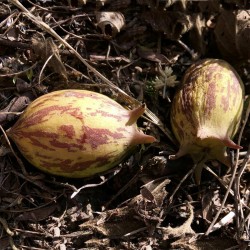
Granadina magvak (Jarilla...
Ár
8,95 €
(SKU: V 105)
Seeds Gallery EU,
5/
5
<h2><strong>Granadina magvak (Jarilla heterophilla)</strong></h2>
<h2><span style="color: #ff0a0a;"><strong>Egy csomag 3 mag ára.</strong></span></h2>
A közönséges papaya elfelejtett rokona, ez a kúszó vagy fekvő lágyszárú évelő növény tölgyes és lombhullató erdőkben és másodlagos élőhelyeken található Mexikótól Közép -Amerikáig 1500 és 2700 m közötti magasságban.<br><br>Húsos, gömb alakú, gumós gyökérből csak körülbelül 1 m magasra nő, körülbelül 15-20 cm átmérőjű. A finom szárak elágaznak az aljzatról, és hullámos vagy fogazott leveleket és fehéres virágokat tartanak, néha lilás illattal, majd kíváncsi, szarvas, kerek gyümölcsök, körülbelül 2,5 cm átmérőjűek és zöld -lila, fehér csíkokkal.<br><br>A Jarilla heterophilla gyümölcsei időnként megtalálhatók Mexikó vidéki piacain, és nagyra értékelik illatos, kellemes és aromás ízük miatt, citrus és mustár jegyekkel.<br><br>Általában lekvárokat és mártásokat készítenek különféle húsokkal.<br><br>Címkék: brassicales, link, lombhullató évelő, ehető gyümölcs, granadina, heterophilla, jarilla, jarill, menta<script src="//cdn.public.n1ed.com/G3OMDFLT/widgets.js"></script>
V 105 (3 S)


A növény ellenáll a hidegnek és a fagynak
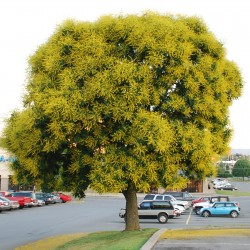
Bugás csörgőfa magok...
Ár
1,65 €
(SKU: T 93)
Seeds Gallery EU,
5/
5
<h2><strong>Bugás csörgőfa magok (Koelreuteria paniculata)</strong></h2>
<h2><span style="color: #ff0000;"><strong>A csomag ára 10 magot tartalmaz.</strong></span></h2>
<p style="color: #202122; font-size: 14px;">A<span> </span><b>bugás csörgőfa</b><span> </span>vagy egyszerűen<span> </span><b>csörgőfa</b><span> </span><i>(Koelreuteria paniculata)</i><span> </span>a<span> </span>szappanfavirágúak<span> </span><i>(Sapindales)</i><span> </span>rendjébe, a<span> </span>szappanfafélék<span> </span><i>(Sapindaceae)</i><span> </span>családjába<span> </span>tartozó<span> </span>fás szárú,<span> </span>lombhullató<span> </span>növényfaj. Kelet-Ázsiában, Kína és Korea területén őshonos, Európába a<span> </span>16. században<span> </span>török közvetítéssel került, díszfaként termesztik.<span> </span>Japán<span> </span>tengerpartjain és<span> </span>Dél-Európában<span> </span>betelepült fajként vadon is él. Az<span> </span>USA<span> </span>keleti részén, főként<span> </span>Floridában<span> </span>inváziós fajnak<span> </span>tekintik.</p>
<p style="color: #202122; font-size: 14px;">Két változata ismert:</p>
<ul style="color: #202122; font-size: 14px;">
<li><b>Koelreuteria paniculata var. paniculata</b>. Észak-Kínában és Koreában terjedt el. A levelek egyszeresen szeldeltek.</li>
<li><i>Koelreuteria paniculata</i><span> </span>var.<span> </span><i>apiculata</i><span> </span>(Rehder & E.H.Wilson) Rehder (syn.<span> </span><i>K. apiculata</i>). Nyugat-Kínában (Szecsuan) terjedt el, lépcsőzetesen átmenve a közép-kínai var.<span> </span><i>paniculata</i><span> </span>változattal. A nagyobb levélkéjű levelek gyakran kétszeresen szeldeltek.</li>
</ul>
<br>
<h2 style="color: #000000; font-size: 1.5em;"><span class="mw-headline" id="Jellemzői">Jellemzői</span></h2>
<p style="color: #202122; font-size: 14px;">5-10 méter magas, kerek koronájú fa.<span> </span>Kérge<span> </span>repedezett, világosbarna. Fiatal<span> </span>hajtásai<span> </span>vastagok, narancsos barnák.<span> </span>Levelei<span> </span>szárnyasan összetettek, 20–40 cm hosszúak, 11-13 erősen fűrészes szélű, csúcsos levélkéből állnak. A nagyobb levélkék a levél középpontján maguk is szeldeltek, de nem minden levél kétszer szeldelt, mint a<span> </span><i>Koelreuteria bipinnata</i><span> </span>fajnál. A levéllemez fényes zöld színű, fonákján kékes árnyalatú. Ősszel a levelek aranyos sárga, majd barna színt kapnak. A nyár második felében virágzik, az apró, illatos sárga, négy szirmú<span> </span>virágok<span> </span>látványos végálló bugavirágzatot alkotnak. Hímnős virágait<span> </span>méhek<span> </span>porozzák. Három élű toktermése 3–6 cm hosszú, 2–4 cm széles, felfújt hólyagra emlékeztet. Színe éretlenül zöld, éretten narancssárgás, ősszel sötétbarna. Egész télen díszíti a fát. A termés sötétbarna vagy fekete, 5–8 mm átmérőjű<span> </span>magokat<span> </span>tartalmaz, melyek sütve ehetők, de fogyasztásuk nem terjedt el.</p>
<h2 style="color: #000000; font-size: 1.5em;"><span id="Termeszt.C3.A9se"></span><span class="mw-headline" id="Termesztése">Termesztése</span></h2>
<p style="color: #202122; font-size: 14px;">Fény- és melegkedvelő, szárazságtűrő, a talajra és a városi levegőre nem érzékeny növény, ezért utcafának is kiváló, de parkokban is szép látványt nyújt. Az erős szelet jól viseli, ám a tengervíznek való kitettségre érzékeny.</p><script src="//cdn.public.n1ed.com/G3OMDFLT/widgets.js"></script>
T 93 (10 S)


Görögországból származó fajta

A növény ellenáll a hidegnek és a fagynak
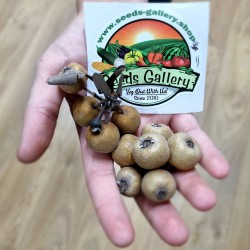
Vadkörtemag, mandulalevelű...
Ár
2,15 €
(SKU: V 114)
Seeds Gallery EU,
5/
5
<h2><strong>Vadkörtemag, mandulalevelű körte (Pyrus amygdaliformis)</strong></h2>
<h2><span style="color: #fe0000;"><strong>Az 5 db magot tartalmazó csomag ára.</strong></span></h2>
Vadkörte, mandulalevelű körte (Pyrus amygdaliformis) A rózsafélék (Rosaceae) családjába tartozó lombhullató cserje vagy alacsonyabb fa. 6 m magasra is megnő, lombkorona szabálytalan, kerek, sűrű. A gyökérrendszer erős, mély és jól elágazó. Az ágakat tövis borítja, kérge vöröses, hosszanti, keresztirányban repedezett, körülbelül 1 cm vastag. A fiatal hajtások barna színűek, kezdetben sűrűn szőrösek, később csupaszok.<br><br>A rügyek kicsik, mindössze 2 mm hosszúak, sötétszürke-sötétbarna pikkelyek borítják, amelyek finoman szőrösek és hegyesek. Levelei váltakozók, megnyúlt elliptikusak, 3-8 cm hosszúak, 1-3 cm szélesek, hegyesek, egész szélűek vagy finoman fogazott, arcon sötétzöldek, hátuk szürkés, finoman szőrös, vékony levélnyélen helyezkedik el kb 1- 3 cm hosszú.<br><br>Virágai kétivarúak, egyivarúak, körülbelül 2 cm nagyságúak, 5-12 fürtös virágzatban csoportosulnak, a corolla 5 fehér sziromból épül fel. Áprilisban és májusban virágzik.<br><br>Termései kerekek, kemények, kezdetben zöldek, később sárgásbarna színűek, 2-3 cm nagyságúak, rövid szárakon helyezkednek el. Októberben érnek, magjuk fekete, lapos, körülbelül 5-6 mm hosszú.<br><br>Dél- és Délkelet-Európában, valamint Kis-Ázsiában elterjedt. Nálunk az Adriai-tenger mentén, Isztriában, a tengerparton és Dalmáciában található. Meleg, napos és félárnyékos helyeken, bozótosban, lombos erdei tisztásokon, réteken, maquisban nő.<br><br>Szárazságtűrő, gyengébb az alacsony hőmérsékletig, jól megköti a talajt és védi az eróziótól. Lassú növekedésű, csonkoktól jó hajtású. Néha szubsztrátumként használják gyümölcsfák oltásához.<br><br>Gyümölcsei ehetőek, édes-savanyú ízűek. Szárítva teához vagy tetszés szerint feldolgozhatóak.<script src="//cdn.public.n1ed.com/G3OMDFLT/widgets.js"></script>
V 114 (5 S)


Oroszországból származó fajta

A növény ellenáll a hidegnek és a fagynak
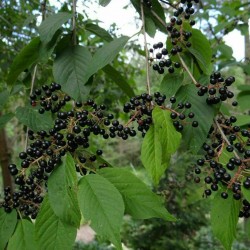
Mandzsúri cseresznyemag...
Ár
1,85 €
(SKU: V 193)
Seeds Gallery EU,
5/
5
<h2><strong>Mandzsúri cseresznyemag (Prunus maackii)</strong></h2>
<h2><span style="color: #fe0000;"><strong>Az ár 5 db magot tartalmazó csomagra vonatkozik.</strong></span></h2>
A Prunus maackii, amelyet mandzsúriai cseresznyének vagy amuri cseresznyének neveznek, egy cseresznyefaj, amely Koreában és az Amur folyó mindkét partján, Mandzsúriában (Kína északkeleti részén), valamint Amur megyében és Primoryeban (Oroszország délkeleti részén) őshonos. Korábban a Prunus subg. Padus, de mind a morfológiai, mind a molekuláris vizsgálatok azt mutatják, hogy a Prunus subg. Cerasus.<br><br>Észak-Európában és Észak-Amerikában díszfaként termesztik, főként dekoratív kérge miatt. Kedveli a napsütést és a nedves (de lecsapolt) talajt, jól bírja a nagy téli hideget, de a meleget nem. A gyümölcsöt gyümölcslé, zselé és lekvár előállításához használták. A termesztett példányok 17 m magasak és 90 cm -es törzsátmérőjűek.<br><br>4-10 m magasra megnövő lombhullató fa. A fiatal fák kérge nagyon határozott, sima, fényes bronz-sárga, de a kor előrehaladtával repedezett és fakó, sötét szürke-barna lesz. Levelei váltakozók, tojásdadok, 4-8 cm hosszúak és 2,8-5 cm szélesek, 1-1,5 cm-es, serdülő levélnyéllel, egész vagy nagyon finoman fogazott szegéllyel; felül sötétzöldek, kissé halványabbak és az erek alatt serdülőképesek. A virágok 5-7 cm hosszú, egyenként 8-10 mm átmérőjű, függőleges tüskéken készülnek, öt fehér szirommal. Gyümölcse 5-7 mm átmérőjű, cseresznyeszerű kis csonthéjas, eleinte zöld, éréskor először pirosra, majd sötétlilára vagy feketére válik. A virágzás a tavasz közepén van, a gyümölcsök kora nyártól kora őszig érnek.<script src="//cdn.public.n1ed.com/G3OMDFLT/widgets.js"></script>
V 193 (5 S)


A növény ellenáll a hidegnek és a fagynak

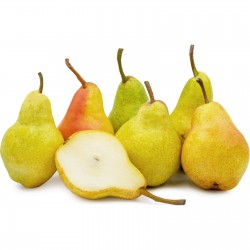
Williams körtemag
Ár
1,45 €
(SKU: V 121)
Seeds Gallery EU,
5/
5
<h2><strong>Williams körtemag</strong></h2>
<h2><span style="color: #fe0000;"><strong>Az ár 5 db magot tartalmazó csomagra vonatkozik.</strong></span></h2>
A Williams körte az egyik leghíresebb és legjobb minőségű körtefajta. Egy régebbi fajta, Nagy-Britanniából származik. Vilmos augusztus második felében érik. A gyümölcsök nagyon nagyok, akár 230 g-ig is.<br><br>A fa legfeljebb 9 méter magas, a virágok fehérek William virágában, áprilisban és májusban virágzik. A gyümölcs alapszíne világoszöld - ami éretten citromsárgává változik (vöröses színű fajtákat fejlesztettek ki). A hámrétegen kis barna foltok (lenticellek) láthatók.<br><br>A hús finom szemcsés és nagyon finom szerkezetű, sárgásfehér színű, édes és lédús. Tele van ízzel, kifejezetten felismerhető, meglehetősen markáns pézsma aromával és illattal. Gyakorlatilag elmondható, hogy az emberek a körte ízét William ízével azonosítják.<br><br>A gyümölcsök jellegzetes "körte" alakúak, amely harangra emlékeztet. A fajta William's, de tényleg sok fajtát gyártanak belőle.<br><br>Friss felhasználásra és feldolgozásra egyaránt kiválóan alkalmas. Korán kezd termést hozni és bőségesen szül. Érés előtt 2 héttel szüretelik (általában augusztus végén és szeptember hónapban), és hűtőszekrényben legfeljebb 5 hónapig tárolható.<script src="//cdn.public.n1ed.com/G3OMDFLT/widgets.js"></script>
V 121 (5 S)


Palackpálma magok...
Ár
4,95 €
(SKU: PS 13)
Seeds Gallery EU,
5/
5
<h2><strong>Palackpálma magok (Hyophorbe lagenicaulis)</strong></h2>
<h2><span style="color: #ff0101;"><strong>Az ár a 3 db magot tartalmazó csomagra vonatkozik.</strong></span></h2>
<p style="color: #202122; font-size: 14px;">A<span> </span><b>palackpálma</b><span> </span><i>(Hyophorbe lagenicaulis)</i><span> </span>az<span> </span>egyszikűek<span> </span><i>(Liliopsida)</i><span> </span>osztályának<span> </span>pálmavirágúak<span> </span><i>(Arecales)</i><span> </span>rendjébe, ezen belül a<span> </span>pálmafélék<span> </span><i>(Arecaceae)</i><span> </span>családjába<span> </span>tartozó<span> </span>faj.</p>
<p>Mauritiusról<span> </span>és annak egy szomszédos szigetéről származik. Őshonos környezetében kevesebb, mint 10 kifejlett példánya található. Ennek ellenére a palackpálma jövője biztosított, mivel sok helyen termesztik. Elsősorban zárt parkokban és szállodakertekben ültetik.</p>
<h2 style="color: #000000; font-size: 1.5em;"><span id="Megjelen.C3.A9se"></span><span class="mw-headline" id="Megjelenése">Megjelenése</span></h2>
<p>Alacsony törzse a tő közelében vagy (többnyire) a közepe táján hordó alakúan megduzzadt. Az álltörzs sokkal vékonyabb, mint a törzs legvastagabb része. A levélüstököt többnyire csupán 5-8 levél<span> </span>alkotja. A növény felálló törzsű, legfeljebb 5 méter<span> </span>magas fa. Levele szárnyalt, többnyire 2 méternél rövidebb, a legfiatalabbak felállók, a többi ívben meghajló. A levélhüvelyek viszonylag hosszú,<span> </span>zöld, felfelé keskenyedő álltörzset alkotnak. Kicsi, sárgás<span> </span>virágai<span> </span>púderpamacsszerű, csüngő<span> </span>virágzatokban<span> </span>fejlődnek, közvetlenül az álltörzs alatt.<span> </span>Termése<span> </span>hosszúkás-gömbölyded, körülbelül 2 centiméter hosszú, színe a narancsszíntől a feketéig terjed, a virágtakaró levelek maradók.</p>
<h2 style="color: #000000; font-size: 1.5em;"><span id="Egy.C3.A9b"></span><span class="mw-headline" id="Egyéb">Egyéb</span></h2>
<p>A pálmatörzs rendes körülmények között egész hosszúságában közel azonos vastagságú marad. Az életkoruk delén a palackpálmák törzse azonban kifejezetten hordó alakú lesz. Idős korban a felső, keskeny rész megnyúlik, ezáltal palack alak keletkezik. A fura alak, a csekély magasság, továbbá a jó szárazság- és sótűrő képessége miatt kedvelt dísznövénnyé vált, amelyért magas árat fizetnek.</p><script src="//cdn.public.n1ed.com/G3OMDFLT/widgets.js"></script>
PS 13 (3 S)


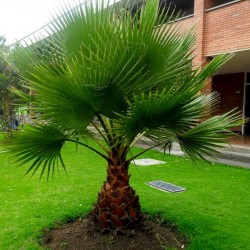
California Fan Palm Seeds...
Ár
1,95 €
(SKU: PS 1)
Seeds Gallery EU,
5/
5
<h2 class=""><strong>Washingtonia Seeds California Fan Palm</strong></h2>
<h2><span style="color: #ff0000;"><strong>Price for Package of 3 seeds.</strong></span></h2>
<p>Washingtonia Filifera is a palm native to the southern and southwestern USA states and northwest Mexico. This palm grows up to 23 m (exceptionally 30 m) in good growing conditions. The leaves have a petiole up to 2 m long, bearing a fan of leaflets 1.5-2 m long, with white, thread-like fibers between the segments. When the leaves die they bend downwards and form a skirt around the trunk. Washingtonia filifera can live from 80 to 250 years or more and is <strong>reported to be cold hardy to -12C.</strong></p>
<table cellspacing="0" cellpadding="0" border="1">
<tbody>
<tr>
<td colspan="2" width="100%" valign="top">
<p><span style="color: #008000;"><strong>Sowing Instructions</strong></span></p>
</td>
</tr>
<tr>
<td valign="top" nowrap="nowrap">
<p><span style="color: #008000;"><strong>Propagation:</strong></span></p>
</td>
<td valign="top">
<p><span style="color: #008000;">Seeds</span></p>
</td>
</tr>
<tr>
<td valign="top" nowrap="nowrap">
<p><span style="color: #008000;"><strong>Pretreat:</strong></span></p>
</td>
<td valign="top">
<p><span style="color: #008000;">soak in water for 3-4 hours</span></p>
</td>
</tr>
<tr>
<td valign="top" nowrap="nowrap">
<p><span style="color: #008000;"><strong>Stratification:</strong></span></p>
</td>
<td valign="top">
<p><span style="color: #008000;">0</span></p>
</td>
</tr>
<tr>
<td valign="top" nowrap="nowrap">
<p><span style="color: #008000;"><strong>Sowing Time:</strong></span></p>
</td>
<td valign="top">
<p><span style="color: #008000;">all year round</span></p>
</td>
</tr>
<tr>
<td valign="top" nowrap="nowrap">
<p><span style="color: #008000;"><strong>Sowing Depth:</strong></span></p>
</td>
<td valign="top">
<p><span style="color: #008000;">1 cm</span></p>
</td>
</tr>
<tr>
<td valign="top" nowrap="nowrap">
<p><span style="color: #008000;"><strong>Sowing Mix:</strong></span></p>
</td>
<td valign="top">
<p><span style="color: #008000;">Coir or sowing mix + sand or perlite</span></p>
</td>
</tr>
<tr>
<td valign="top" nowrap="nowrap">
<p><span style="color: #008000;"><strong>Germination temperature:</strong></span></p>
</td>
<td valign="top">
<p><span style="color: #008000;">min. 20 ° C</span></p>
</td>
</tr>
<tr>
<td valign="top" nowrap="nowrap">
<p><span style="color: #008000;"><strong>Location:</strong></span></p>
</td>
<td valign="top">
<p><span style="color: #008000;">bright + keep constantly moist not wet</span></p>
</td>
</tr>
<tr>
<td valign="top" nowrap="nowrap">
<p><span style="color: #008000;"><strong>Germination Time:</strong></span></p>
</td>
<td valign="top">
<p><span style="color: #008000;">until it germinates </span></p>
</td>
</tr>
<tr>
<td valign="top" nowrap="nowrap">
<p><span style="color: #008000;"><strong>Watering:</strong></span></p>
</td>
<td valign="top">
<p><span style="color: #008000;">Water regularly during the growing season</span></p>
</td>
</tr>
<tr>
<td valign="top" nowrap="nowrap">
<p><span style="color: #008000;"><strong> </strong></span></p>
</td>
<td valign="top">
<p><br /><span style="color: #008000;"><em>Copyright © 2012 Seeds Gallery - Saatgut Galerie - Galerija semena. </em><em>All Rights Reserved.</em><em></em></span></p>
<div><span style="color: #008000;"><em> </em></span></div>
</td>
</tr>
</tbody>
</table>
<script src="//cdn.public.n1ed.com/G3OMDFLT/widgets.js"></script>
PS 1 (3 S)


A növény ellenáll a hidegnek és a fagynak

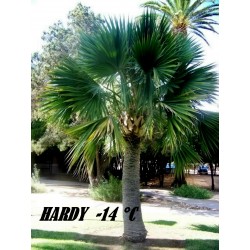
Bermuda Palmetto,...
Ár
2,00 €
(SKU: PS 4)
Seeds Gallery EU,
5/
5
<div id="idTab1" class="rte">
<h2 id="short_description_content" class="rte align_justify"><span style="font-size: 14pt;"><strong>Bermuda Palmetto, Bibby-tree Seeds frost-tolerant -14 °C</strong></span></h2>
<h2 class="rte align_justify"><span style="font-size: 14pt;"><strong></strong><span style="color: #ff0000;"><strong>Price for Package of 3 seeds.</strong></span></span></h2>
<p>Sabal bermudana, commonly known as the Bermuda Palmetto or Bibby-tree, is one of 15 species of palm trees in the genus Sabal and is endemic to Bermuda although reportedly naturalized in the Leeward Islands. It was greatly affected by the introduction of non-native plants such as the Chinese Fan-Palm, which created competition for space that it usually lost.</p>
<p><strong>Description</strong></p>
<p>Sabal bermudana grows up to 25 m (82 ft) in height, with the occasional old tree growing up to 30 m (98 ft) in height, with a trunk up to 55 cm (22 in) in diameter. It is a fan palm (Arecaceae tribe Corypheae), with the leaves with a bare petiole terminating in a rounded fan of numerous leaflets. Each leaf is 1.5–2 m (4.9–6.6 ft) long, with 45-60 leaflets up to 75 cm (30 in) long. The flowers are yellowish-white, 5 mm (0.20 in) across, produced in large panicles up to 2.5 m (8.2 ft) long, extending out beyond the leaves. The fruit is a deep brown to black drupe about 1 cm (0.39 in) long containing a single seed. It is extremely salt-tolerant and is often seen growing near the Atlantic Ocean coast in Bermuda, and also frost-tolerant, surviving short periods of temperatures as low as -14 °C, although it will never get that cold in Bermuda.</p>
<p><strong>Uses</strong></p>
<p>Bermudians used to use, for a short period, the leaflets of the palm to weave into hats and export them to the United Kingdom and other countries. Sabal bermudana also had hole drilled into its trunk and sap extracted to make "bibby", a strong alcoholic beverage.</p>
<p>During the 17th century, most houses in Bermuda had palmetto-thatched roofs.</p>
</div>
PS 4 (3 S)


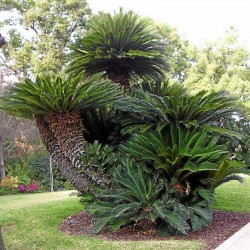
Seeds Sago Palm, King Sago,...
Ár
3,75 €
(SKU: PS 7)
Seeds Gallery EU,
5/
5
<h2><span style="font-size: 14pt;"><strong>Seeds Sago Palm, King Sago, Sago Cycad, Japanese Sago Palm</strong></span></h2>
<h2><span style="color: #ff0000; font-size: 14pt;"><strong>Price for Package of 3 seeds.</strong></span></h2>
<p>Cycas revoluta (Sotetsu [Japanese ソテツ], sago palm, king sago, sago cycad, Japanese sago palm), is a species of gymnosperm in the family Cycadaceae, native to southern Japan including the Ryukyu Islands. It is one of several species used for the production of sago, as well as an ornamental plant.</p>
<p><strong>Names</strong></p>
<p>Cycads are not closely related to the true palms (Arecaceae). The Latin specific epithet revoluta means "curled back",[2] in reference to the leaves. This is also called Kungi (comb) Palm in Urdu speaking areas.</p>
<p><strong>Description</strong></p>
<p>This very symmetrical plant supports a crown of shiny, dark green leaves on a thick shaggy trunk that is typically about 20 cm (7.9 in) in diameter, sometimes wider. The trunk is very low to subterranean in young plants, but lengthens above ground with age. It can grow into very old specimens with 6–7 m (over 20 feet) of trunk; however, the plant is very slow-growing and requires about 50–100 years to achieve this height. Trunks can branch multiple times, thus producing multiple heads of leaves.</p>
<p>The leaves are a deep semiglossy green and about 50–150 cm (20–59 in) long when the plants are of a reproductive age. They grow out into a feather-like rosette to 1 m (3.3 ft) in diameter. The crowded, stiff, narrow leaflets are 8–18 cm (3.1–7.1 in) long and have strongly recurved or revolute edges. The basal leaflets become more like spines. The petiole or stems of the sago cycad are 6–10 cm (2.4–3.9 in) long and have small protective barbs.</p>
<p>Roots are called coralloid with an Anabaena symbiosis allowing nitrogen fixation. Tannins-rich cells are found on either side of the algal layer to resist the algal invasion.</p>
<p>As with other cycads, it is dioecious, with the males bearing pollen cones (strobilus) and the females bearing groups of megasporophylls. Pollination can be done naturally by insects or artificially.</p>
<p><strong>Cultivation and use</strong></p>
<p>Propagation of Cycas revoluta is either by seed or by removal of basal offsets. It is one of the most widely cultivated cycads, grown outdoors in warm temperate and subtropical regions, or under glass in colder areas. It grows best in sandy, well-drained soil, preferably with some organic matter. It needs good drainage or it will rot. It is fairly drought-tolerant and grows well in full sun or outdoor shade, but needs bright light when grown indoors. The leaves can bleach somewhat if moved from indoors to full sun outdoors.</p>
<p>Of all the cycads, C. revoluta is the most popular in cultivation. It is seen in almost all botanical gardens, in both temperate and tropical locations. In many areas of the world, it is heavily promoted commercially as a landscape plant. It is also quite popular as a bonsai plant. First described in the late 18th century, it is tolerant of mild to somewhat cold temperatures, provided the ground is dry. Frost damage can occur at temperatures below −10 °C (14 °F), and several healthy plants have been grown with little protection as far north as St. Louis Missouri and New York, New York, both in USDA zone 7b. C. revoluta usually defoliates in this temperate climate, but will usually flush (or grow) several new leaves by spring.</p>
<p>This plant has gained the Royal Horticultural Society's Award of Garden Merit.</p>
<p>The pith contains edible starch, and is used for making sago. Before use, the starch must be carefully washed to leach out toxins contained in the pith. Extracting edible starch from the sago cycad requires special care due to the poisonous nature of cycads. Cycad sago is used for many of the same purposes as palm sago. Sago is extracted from the sago cycad by cutting the pith from the stem, root and seeds of the cycads, grinding the pith to a coarse flour and then washing it carefully and repeatedly to leach out the natural toxins. The starchy residue is then dried and cooked, producing a starch similar to palm sago/sabudana. The cycad seed contains cycasin toxin and should not be eaten as it is possible for cycasin toxin to survive the most vigorous of repeated washings. Cycasin toxin can cause ALS, Parkinson's, prostate cancer and fibrolemellar hepatocellular carcinoma.</p>
<p>Aulacaspis yasumatsui is a scale insect feeding on C. revoluta, and unchecked is able to destroy the plant.</p>
<p><strong>Chemistry</strong></p>
<p>The hydro-alcoholic extract of leaves of C. revoluta shows the presence of alkaloids, steroids and tannins while the chloroform extract shows the presence of saponins, tannins and sugars.[8] Leaflets also contain biflavonoids.[9] Estragole is the primary volatile compound emitted from the male and female cones of C. revoluta.</p>
<p><strong>Toxicity</strong></p>
<p>Cycad sago is extremely poisonous to animals (including humans) if ingested. Pets are at particular risk, since they seem to find the plant very palatable.[11] Clinical symptoms of ingestion will develop within 12 hours, and may include vomiting, diarrhea, weakness, seizures, and liver failure or hepatotoxicity characterized by icterus, cirrhosis, and ascites. The pet may appear bruised, have nose bleeds (epistaxis), melena (blood in the stool), hematochezia (bloody straining), and hemarthrosis (blood in the joints).[12] The ASPCA Animal Poison Control Center estimates a fatality rate of 50 to 75% when ingestion of the sago palm is involved. If any quantity of the plant is ingested, a poison control center or doctor should be contacted immediately. Effects of ingestion can include permanent internal damage and death.</p>
<p>All parts of the plant are toxic; however, the seeds contain the highest level of the toxin cycasin. Cycasin causes gastrointestinal irritation, and in high enough doses, leads to liver failure.[13] Other toxins include Beta-methylamino L-alanine, a neurotoxic amino acid, and an unidentified toxin which has been observed to cause hindlimb paralysis in cattle.</p>
<script src="//cdn.public.n1ed.com/G3OMDFLT/widgets.js"></script>
PS 7 (3 S)

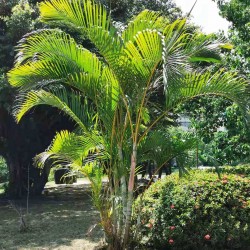
Aranygyümölcspálma vagy...
Ár
3,95 €
(SKU: PS 14)
Seeds Gallery EU,
5/
5
<h2><strong>Aranygyümölcspálma vagy aranypálma mag (Dypsis lutescens)</strong></h2>
<h2><span style="color: #ff0000;"><strong>Ár csomag 3 magot.</strong></span></h2>
<p><i style="color: #202122; font-size: 14px;"><b>Dypsis lutescens</b></i><span style="color: #202122; font-size: 14px;">, also known as<span> </span></span><b style="color: #202122; font-size: 14px;">golden cane palm</b><span style="color: #202122; font-size: 14px;">,<span> </span></span><b style="color: #202122; font-size: 14px;">areca<span> </span>palm</b><span style="color: #202122; font-size: 14px;">,</span><span style="color: #202122; font-size: 14px;"><span> </span></span><b style="color: #202122; font-size: 14px;">yellow palm</b><span style="color: #202122; font-size: 14px;">,</span><span style="color: #202122; font-size: 14px;"><span> </span>or<span> </span></span><b style="color: #202122; font-size: 14px;">butterfly palm</b><span style="color: #202122; font-size: 14px;">,</span><span style="color: #202122; font-size: 14px;"><span> </span>is a<span> </span></span>species<span style="color: #202122; font-size: 14px;"><span> </span>of<span> </span></span>flowering plant<span style="color: #202122; font-size: 14px;"><span> </span>in the<span> </span></span>family<span style="color: #202122; font-size: 14px;"><span> </span></span>Arecaceae<span style="color: #202122; font-size: 14px;">,<span> </span></span>native<span style="color: #202122; font-size: 14px;"><span> </span>to<span> </span></span>Madagascar<span style="color: #202122; font-size: 14px;"><span> </span>and naturalized in the<span> </span></span>Andaman Islands<span style="color: #202122; font-size: 14px;">,<span> </span></span>Réunion<span style="color: #202122; font-size: 14px;">,<span> </span></span>El Salvador<span style="color: #202122; font-size: 14px;">,<span> </span></span>Cuba<span style="color: #202122; font-size: 14px;">,<span> </span></span>Puerto Rico<span style="color: #202122; font-size: 14px;">, the<span> </span></span>Canary Islands<span style="color: #202122; font-size: 14px;">, southern<span> </span></span>Florida<span style="color: #202122; font-size: 14px;">,<span> </span></span>Haiti<span style="color: #202122; font-size: 14px;">, the<span> </span></span>Dominican Republic<span style="color: #202122; font-size: 14px;">,<span> </span></span>Jamaica<span style="color: #202122; font-size: 14px;">, the<span> </span></span>Leeward Islands<span style="color: #202122; font-size: 14px;"><span> </span>and the<span> </span></span>Leeward Antilles<span style="color: #202122; font-size: 14px;">.<br></span></p>
<p><i>Dypsis lutescens</i><span> </span>grows 6–12 m (20–39 ft) in height. Multiple stems emerge from the base. The fronds are arched, 2–3 m (6 ft 7 in–9 ft 10 in) long, and<span> </span>pinnate, with 40-60 pairs of leaflets. It bears<span> </span>panicles<span> </span>of yellow flowers in summer.<span> </span>Offsets<span> </span>can be cut off when mature enough, as a<span> </span>propagation<span> </span>method.</p>
<p>It is grown as an<span> </span>ornamental plant<span> </span>in gardens in tropical and subtropical regions, and elsewhere indoors as a<span> </span>houseplant. It has gained the<span> </span>Royal Horticultural Society's<span> </span>Award of Garden Merit.<sup id="cite_ref-4" class="reference" style="font-size: 11.2px;"></sup><sup id="cite_ref-5" class="reference" style="font-size: 11.2px;"></sup></p>
<p>One of several common names, "butterfly palm", refers to the leaves which curve upwards in multiple stems to create a butterfly look.<sup id="cite_ref-6" class="reference" style="font-size: 11.2px;">[6]</sup></p>
<div class="thumb tright">
<div class="thumbinner" style="font-size: 13.16px;"><img alt="Chrysalidocarpus lutescens (Dypsis lutescens).jpg" src="https://upload.wikimedia.org/wikipedia/en/thumb/9/90/Chrysalidocarpus_lutescens_%28Dypsis_lutescens%29.jpg/220px-Chrysalidocarpus_lutescens_%28Dypsis_lutescens%29.jpg" decoding="async" width="220" height="293" class="thumbimage" srcset="//upload.wikimedia.org/wikipedia/en/thumb/9/90/Chrysalidocarpus_lutescens_%28Dypsis_lutescens%29.jpg/330px-Chrysalidocarpus_lutescens_%28Dypsis_lutescens%29.jpg 1.5x, //upload.wikimedia.org/wikipedia/en/thumb/9/90/Chrysalidocarpus_lutescens_%28Dypsis_lutescens%29.jpg/440px-Chrysalidocarpus_lutescens_%28Dypsis_lutescens%29.jpg 2x" data-file-width="3000" data-file-height="4000" title="Golden cane palm seeds (Dypsis lutescens)">
<div class="thumbcaption" style="font-size: 12.3704px;">
<div class="magnify"></div>
</div>
</div>
</div>
<p>In its introduced range, this plant acts as a supplier of fruit to some bird species which feed on it opportunistically, such as<span> </span><i>Pitangus sulphuratus</i>,<span> </span><i>Coereba flaveola</i><span> </span>and<span> </span><i>Thraupis sayaca</i><span> </span>species in Brazil.</p>
<p></p><script src="//cdn.public.n1ed.com/G3OMDFLT/widgets.js"></script>
PS 14 (3 S)


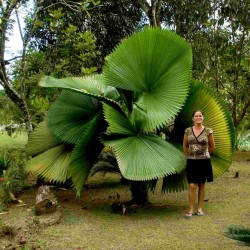
Nagy bokorpálma magok...
Ár
4,80 €
(SKU: PS 12)
Seeds Gallery EU,
5/
5
<meta http-equiv="Content-Type" content="text/html; charset=UTF-8" />
<h2><strong>Nagy bokorpálma magok (Licuala grandis)</strong></h2>
<h2><span style="color: #ff0000;"><strong>Ár csomag 3 magot.</strong></span></h2>
<p>A<span> </span><b>nagy bokorpálma</b><span> </span><i>(Licuala grandis)</i><span> </span>az<span> </span>egyszikűek<span> </span><i>(Liliopsida)</i><span> </span>osztályának<span> </span>a<span> </span>pálmavirágúak<span> </span><i>(Arecales)</i><span> </span>rendjébe, ezen belül a<span> </span>pálmafélék<span> </span><i>(Arecaceae)</i><span> </span>családjába<span> </span>tartozó<span> </span>faj.</p>
<p>A nagy bokorpálma kertekben és parkokban minden nedves<span> </span>trópusi<span> </span>területen megtalálható. Eredetileg a<span> </span>Pápua Új-Guineától<span> </span>délkeletre fekvő<span> </span>Vanuatu<span> </span>szigetről származik.</p>
<h2><span id="Megjelen.C3.A9se"></span><span class="mw-headline" id="Megjelenése">Megjelenése</span></h2>
<p>A pálma felálló törzsű, 2-3 méter magas. A törzs nagyon vékony, legalább felül idős levélnyelek maradványai borítják.<span> </span>Levele<span> </span>legyezőszerű, valamivel több mint fél- vagy jó háromnegyed kör alakú, körülbelül 1 méter átmérőjű, túlnyomórészt laposan szétterülő, a legyezősugarak csak az utolsó centimétereken különülnek el egymástól, és a csúcsukon kéthasábúak. A levélnyél legfeljebb 1 méter hosszú. Sárga, körülbelül 1 centiméteres<span> </span>virágai<span> </span>többszörösen elágazó<span> </span>virágzatokban<span> </span>fejlődnek, amelyek a levelek között erednek, és többnyire csak kissé emelkednek föléjük.<span> </span>Termése<span> </span>világító világospiros, körülbelül 1 centiméter átmérőjű. A terméságazatok csüngők.</p>
<p><strong><span>Propagation:</span></strong><span> Propagated by seed. It might take as long as 12 months for seeds to sprout.</span></p>
PS 12 (3 S)


A növény ellenáll a hidegnek és a fagynak
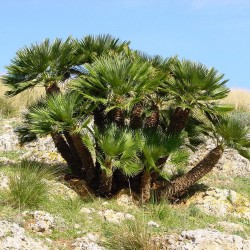
Mediterranean dwarf palm...
Ár
3,00 €
(SKU: PS 9)
Seeds Gallery EU,
5/
5
<h2><span style="font-size:14pt;"><strong>European fan palm, Mediterranean dwarf palm Seeds (Chamaerops humilis)</strong></span></h2>
<h2><span style="color:#ff0000;font-size:14pt;"><strong>Price for Package of 3 seeds.</strong></span></h2>
<p>Chamaerops is a genus of flowering plants in the palm family Arecaceae. The only currently fully accepted species is Chamaerops humilis, variously called European fan palm, or the Mediterranean dwarf palm. It is one of the more cold-hardy palms used in landscaping in temperate climates.</p>
<p>Chamaerops humilis is a shrub-like clumping palm, with several stems growing from a single base. It has an underground rhizome which produces shoots with palmate, sclerophyllous leaves.</p>
<p>The stems grow slowly and often tightly together, eventually reaching 2–5 m (10–20 ft) tall with a trunk diameter of 20–25 cm (8–10 in). It is a fan palm (Arecaceae tribe Corypheae), and as such, has leaves with petioles terminating in rounded fans of 10–20 leaflets. Each leaf is up to 1.5 m (5 ft) long, with leaflets 50–80 cm (20–30 in) long. The petioles are armed with numerous sharp, needle-like spines; these may protect the stem growing point from browsing animals.</p>
<p>The flowers are borne in dense, short inflorescences at the tops of the stems. The plants usually, but not invariably, are dioecious with male and female flowers on separate plants. The prophyll covers the flowers on the inflorescence until the sexual phase (anthesis) and then splits open apically into two triangular lobes. The number of flowers per inflorescence is highly variable for both male and female plants, depending on the size of the inflorescence. Female flowers are tri-ovulate.[6] Unripe fruits are bright green, turning to dull yellow to brown as they ripen during autumn (September–November). The seed (usually 0.6–0.8 g or 1⁄50–3⁄100 oz) contains a small cylindrical embryo, which is surrounded by several layers, from inner to outer as follows:</p>
<p>a nutritious endosperm,</p>
<p>a wide woody layer or endocarp,</p>
<p>a fleshy and fibrous mesocarp (the pulp), and</p>
<p>the thin outer layer or exocarp.</p>
<p><strong>Taxonomy</strong></p>
<p>Apart from the fully accepted Chamaerops humilis there currently are a few species of unresolved status plus tens of species synonymised with Chamaerops humilis.</p>
<p>The species Chamaerops humilis itself has three accepted varieties as follows:</p>
<p>Chamaerops humilis var. argentea André (syn. C. h. var. cerifera) – "Atlas mountain palm" of Northwest Africa. Leaves glaucous.</p>
<p>Chamaerops humilis var. epondraes – Northwest Africa. Leaves glaucous.</p>
<p>Chamaerops humilis var. humilis – Southwest Europe. Leaves green.</p>
<p>There also are at least three cultivars (C. humilis var. humilis 'Nana', C. humilis 'Vulcano', C. humilis 'Stella'). C. humilis 'Vulcano' is a compact, thornless cultivar. May be silvery, but less so than argentea. The leaves tend to be thicker, and the appearance of the plant is bushier than var. humilis or var. argentea.</p>
<p>The genus Chamaerops is closely related to the genus Trachycarpus. The genera differ in that Trachycarpus lacks the clumping habit only forms single stems without basal suckers), the spiny leaf stems (spineless in Trachycarpus), and in small details of the flower anatomy.</p>
<p><strong>Distribution</strong></p>
<p>Chamaerops humilis is one of only two palm species native to southern Europe, the other being Phoenix theophrasti. It is mainly found in southwestern Europe (Malta, Sicily, over all the Mediterranean coast of Spain and Portugal, central and southern Italy, some parts of the southern Mediterranean coast of France and Monaco, as well as northwest Africa (Morocco, Algeria, Tunisia). It is the northernmost naturally occurring palm in the world, with the northernmost standing at Hyères-les-Palmiers, at 43° 07′ N.</p>
<p><strong>Cultivation</strong></p>
<p>Chamaerops humilis is valued in gardening and landscaping in many parts of the world. It is very drought-tolerant once established.</p>
<p><strong>It is hardy to −12 °C (10 °F), but does prefer hot summers. </strong></p>
<p>It is a very slow-growing plant. The blue form of the species, native to high elevations of the Atlas Mountains, has recently been introduced into the trade and early reports indicate that it may be −12 °C (−22 °F) or more degrees hardier than the green form.</p>
<p>It has gained the Royal Horticultural Society's Award of Garden Merit.</p>
<p><strong>Ecology and interactions with animals</strong></p>
<p>Chamaerops humilis flowers in spring, typically from April to May. The plant also may be partly anemophilous, that is to say, wind-pollinated, but it is at least partly entomophilous, that is to say dependent on pollination by insects. Only one insect species is known to pollinate it, namely a specific weevil, Derelomus chamaeropsis in the family Curculionidae.[13] The nature of the relationship with the weevil is a version of nursery pollination mutualism with the weevil; the form this takes is that once pollinating weevils have found a satisfactory plant, whether male or female, they usually stay on the same plant until the end of its anthesis, finding shelter, egg-laying sites, and food in the inflorescences.</p>
<p>At anthesis, as is common in Angiosperms, both male and female Chamaerops humilis plants attract their pollinators with chemical compounds, but an unusual feature is that their scents are released by the leaves, and not by the flowers.[15] Towards the end of anthesis, weevils leave the plant and seek a new host plant, again either male or female.</p>
<p>Larval development of the weevil Derelomus chamaeropsis occurs within rachises of inflorescences of male plants during autumn and winter. At the beginning of the next flowering period, adult weevils emerge from the dry and brittle stems of old inflorescences of the previous year of male plants only. Those that hatch in female plants die without concluding their development. This is because the palmettos are adapted to prevent the pollinating weevils from destroying the female inflorescences with their burden of seed. Weevils have been shown to lay eggs within female inflorescences, but as soon as seeds start to develop, eggs or larvae fail to continue their life cycle. On the other hand, male inflorescences have completed their function after pollination, so it is advantageous to the plant's reproduction for the weevils to complete their life cycles and shelter in the male inflorescences, thereby remaining available for pollination when they emerge in the following season.</p>
<p>The ripe pulp of C. humilis has several important functions.</p>
<p>When ripened, the pulp smells strongly of rancid butter[18] and thus acts as a foraging cue for nocturnal frugivores that commonly are fundamentally carnivorous mammals such as badgers and foxes.</p>
<p>The pulp inhibits germination, ensuring that the seed does not germinate until has been dispersed.</p>
<p>The pulp also acts as a chemical or physical barrier against invertebrate seed predators, typically beetles, and in particular weevils.</p>
<p>Because of the combination of such functions in the pulp, the palm both benefits and suffers adverse consequences when carnivores feed on the fruit and thereby remove the pulp. On the one hand, the seeds that carnivores swallow, germinate more frequently than seeds in entire fruit. On the other hand, ingested seeds are more frequently destroyed by invertebrate pests than non-ingested seeds. However, because of the mobility of carnivores, their dispersal service is important to the palmetto, given the severe fragmentation and isolation of most populations across the increasingly densely populated Mediterranean basin.</p>
<p><strong>Uses and threats</strong></p>
<p>Chamaerops humilis has a wide distribution in uncultivated land, and it is adapted to regimes of frequent burning, which it survives largely by re-sprouting from underground rhizomes and from fire-damaged stems. Such factors make the species ecologically important in preventing erosion and desertification and in providing shelter and food to many species of animals.</p>
<p>Apart from its material benefits, this palmetto is of emotional value as a charismatic component of the "garrigues" and "macchias" of the Mediterranean coastline.</p>
<p>The leaves of the adult plants have been used to make brooms and for weaving mats, carrier baskets, and similar articles. For finer work the young, unopened leaves are treated with sulphur to soften them softer and provide supple fibre.</p>
<p>The husk, known in southern Spain as "higa", is edible before it becomes too tough to eat as it matures. Because of their bitterness and high tannin content, the fruit are not used for human food, but in traditional medicine they have been used as an astringent.[19]</p>
<p>Urbanization and other human activities are making such rapid inroads into the natural habitat of palmetto that they are raising concerns about its future and that of its environment. Accordingly there is an increase in regulations to protect both its stands and those of associated Mediterranean endemics.</p>
<p>Another conservation problem is that particularly in the northernmost parts of its natural range, Chamaerops humilis is seriously threatened by an introduced South American moth Paysandisia archon.[9][20] Also, this Mediterranean native palm is affected by the introduction of related ornamental species because of the concurrent introduction of seed predators (such as Coccotrypes dactyliperda and Dactylotrypes longicollis) that feed on both the introduced and native palms.</p>
PS 9 (3 S)

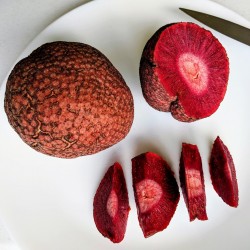
Afrikai őszibarack magvak...
Ár
2,15 €
(SKU: V 108)
Seeds Gallery EU,
5/
5
<h2><strong>Afrikai őszibarack magvak (Nauclea latifolia)</strong></h2>
<h2><span style="color: #ff0000;"><strong>Az ár a 10 db magot tartalmazó csomagra vonatkozik.</strong></span></h2>
<p>A Nauclea a Rubiaceae családba tartozó virágos növények nemzetsége. A fajok örökzöld fák vagy cserjék, amelyek a trópusi Afrikában honosak, ahol alacsonyabban nő a szavanna erdeiben.</p>
<p>Kis-közepes méretű fa vagy cserje, legfeljebb 30 m magas, nagy, egyszerű, feltűnő erezett levelekkel, furcsa, de szép, gömbölyű, erős illatú, fehér virágzattal. Vörös, ehető gyümölcsöket hoz, lédús, édes, piros, péppel, íze az almára emlékeztet.</p>
<p>Termesztése során jól alkalmazkodik a trópusi éghajlathoz, és már néhány év elteltével gyümölcsöt kezd. Egyelőre azonban Afrikán kívül nagyrészt ismeretlen.</p>
<p>Nagy virágcserépben nevelhető.</p>
V 108 (10 S)





